
China has significantly tightened its export controls on rare earth elements, adding five new materials to the list and imposing more regulations on semiconductor users. This move comes as the world’s largest rare earth producer seeks to assert control over a critical sector ahead of anticipated discussions between Donald Trump and Xi Jinping later this month.
The new measures, announced by China’s Ministry of Commerce, come in light of broader calls from US politicians for increased restrictions on the export of chipmaking equipment to China. The latest changes expand upon regulations introduced in April, which had already disrupted supply chains globally. These earlier restrictions led to shortages before agreements with Europe and the US helped alleviate some of the pressure.
In a statement to Reuters, a White House official indicated that the administration is closely monitoring the implications of these regulations, which were unveiled without prior notice. The official described the measures as an apparent effort by China to exert control over global technology supply chains.
Tim Zhang, founder of Singapore-based Edge Research, noted that these new restrictions enhance Beijing’s leverage ahead of the upcoming summit between the two leaders in South Korea. China currently dominates the rare earth market, producing over 90 percent of the world’s processed rare earths and magnets, which are essential for a wide range of products, including electric vehicles, military radars, and aircraft engines.
The recent announcements specify that exports of twelve rare earth elements will now be restricted. The five newly added elements—holmium, erbium, thulium, europium, and ytterbium—join the existing list of controlled materials. Furthermore, foreign companies that produce these rare earths or related magnets will now require a Chinese export license if their final products incorporate Chinese materials or equipment. This requirement applies even if no Chinese entities are involved in the transaction.
These regulations mirror actions taken by the US to limit semiconductor-related exports to China. The specifics of how Beijing will enforce these new rules remain unclear, especially as the US and its allies are working to establish alternative rare earth supply chains independent of China.
Neha Mukherjee, a rare earths analyst with Benchmark Mineral Intelligence, remarked that this situation may lead to a structural bifurcation, with China localizing its supply chain while the US and its allies accelerate their own efforts.
To address concerns over potential supply shortages, the Ministry of Commerce stated that the scope of restrictions is limited and that various licensing facilitation measures will be implemented. The new regulations regarding the five additional elements and processing equipment will take effect on November 8, just before a 90-day trade truce with the US expires. Rules affecting foreign companies using Chinese materials or equipment will begin on December 1.
The new export laws will not grant licenses to overseas defense users and will require advanced semiconductor applications to be approved on a case-by-case basis. These advanced semiconductors are critical for producing devices ranging from smartphones to AI systems with military applications.
Amid these developments, South Korea, home to major semiconductor manufacturers such as Samsung Electronics and SK Hynix, is reviewing the implications of China’s new restrictions. The South Korean industry ministry has stated that it will engage in discussions with China to mitigate any adverse effects from the new policies.
As the global landscape continues to evolve, the ramifications of China’s rare earth export controls may significantly impact technology sectors worldwide, shaping the dynamics of international trade and cooperation in the coming months.







